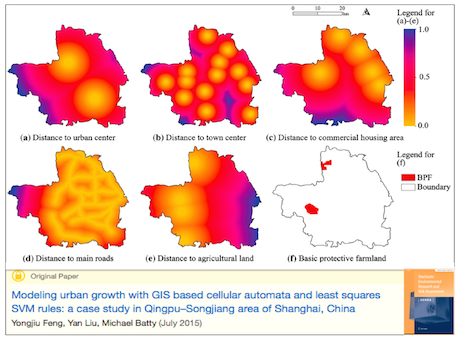Urban CA models use sets of rules that are applied to each cell in the geographical array to change the state of the cell usually according to attributes that exist in the neighbourhood of the cell in question. As there are usually many thousands of cells and therefore large quantities of data that map one time slice of the system into the next one, then in CA models there is the opportunity to search for pattern in these changes of state, thus deriving transition rules from this data. Ten years or more ago, when Claudia Maria de Almeida from INPE (National Institute for Space Research, Brazil) visited us in CASA, I worked with her on her CA models of development change in Brazilian cities and she developed a number of multivariate methods for extracting the rules from the dynamics of cellular change. The 2003 paper can be downloaded here. Recently I have worked with Yan Liu from Brisbane (U Queensland) and Yongjiu Feng from Shanghai (College of Marine Sciences) on developing a machine learning approach to extracting nonlinear transition rules based on least squares support vector machines which essentially define the patterns needed get appropriate rules. It is all quite tricky stuff in detail but rather generic in terms of what these methods are designed to do. We published a paper recently on this in the journal Stochastic Environmental Research Risk Assessment (Volume 29, 2015, online) and if you click here you can see a copy of the paper and its source. Enjoy.
Calibrating Cellular Automata (CA)
This entry was posted in Agent-Based Models, Cellular Automata, Information, Urban Dynamics. Bookmark the permalink.









